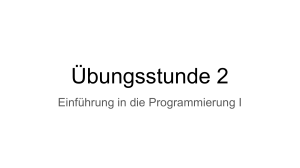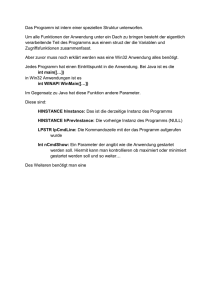int
Werbung
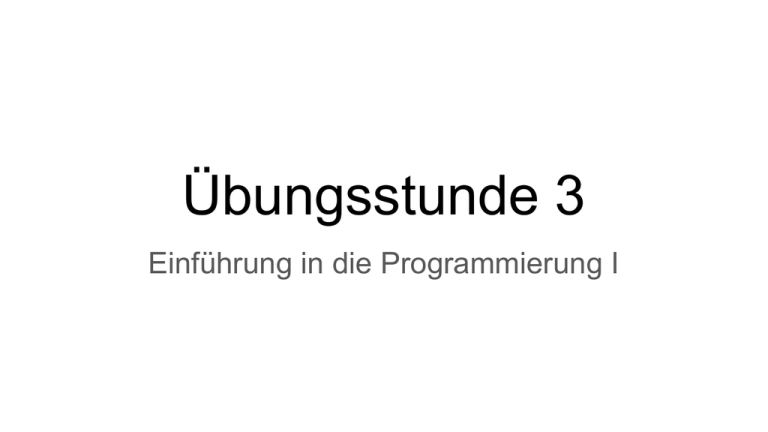
Übungsstunde 3
Einführung in die Programmierung I
Probleme bei Übung 2
[TODO Assistent]
Nachbesprechung Übung 3
Aufgabe 1: Folgen und Reihen
import java.util.Scanner;
public class Reihe {
public static void main(String[] args) {
Scanner scanner = new Scanner(System.in);
System.out.print("Geben Sie eine natürliche Zahl ein: ");
int n = scanner.nextInt();
if(n < 0) {
System.out.println("Keine natürliche Zahl!");
}
else {
Wichtig: Überprüfung der
double sum = 0;
for(int i = 1; i <= n; i++) {
Benutzereingabe
sum += 1.0 / (i * i);
}
System.out.println(sum);
}
}
Achtung: Double-Division
}
erzwingen
Aufgabe 2: Binärdarstellung
// Finde twoToTheK = 2^k <= z
int k = 0;
int twoToTheK = 1;
while(z >= twoToTheK) {
k++;
twoToTheK *= 2;
}
k--;
twoToTheK /= 2;
// Drucke einzelne Ziffern der Binaerdarstellung von z
while(k >= 0) {
int digit = z / twoToTheK;
System.out.print(digit);
z -= digit * twoToTheK;
k--;
twoToTheK /= 2;
}
System.out.println();
Aufgabe 3: Sieb des Eratosthenes
boolean[] sieb = new boolean[limit + 1];
for(int i = 2; i < sieb.length; i++)
sieb[i] = true;
// Gehe alle Zahlen bis limit durch und setze Vielfache davon auf false
for(int i = 2; i < limit; i++) {
if(sieb[i]) {
for (int vielfaches = 2 * i; vielfaches <= limit; vielfaches += i) {
sieb[vielfaches] = false;
}
}
}
// Zaehle uebrig gebliebene Zahlen - Primzahlen
int primzahlen = 0;
for(int i = 2; i < sieb.length; i++)
if(sieb[i])
primzahlen++;
System.out.println(primzahlen);
Aufgabe 4: Grösster gemeinsamer Teiler
while(x <= y || x % y != 0) {
// Zwischenspeichern von y
int altY = y;
y = x % y;
x = altY;
}
System.out.println(y);
Negation der Bedingung in 1.
Vorbesprechung Übung 4
siehe auch: https://de.wikipedia.org/wiki/Newton-Verfahren,
vor allem Berechnung der Quadratwurzel
Kommentare um
verschiedene Versionen
von vector zu testen
Zusatzübungen
Boolsche Ausdrücke
Was ergibt die Auswertung dieser boolschen Ausdrücke? (a, b vom Typ boolean; x, y, z vom Typ int)
x = 12; y = 7; z = 5;
x % y == z || x < y
y < x && y <= z
x % 2 == y % 2 || x % 2 == z % 2
x <= y + z && x >= y + z
!(x < y && x < z)
(x + y) % 2 == 0 || !((z - y) % 2 == 0)
(!(a&&b) && (a||b)) || ((a&&b) || !(a||b))
Boolsche Ausdrücke
Vereinfachen Sie den Ausdruck (a und b sind vom Typ int):
(!(a < b) && !(a > b))
Schleifen
Wie oft wird diese while-Schleife durchlaufen? Ausgabe des Programms?
int x = 1;
System.out.print(x);
while (x < 100) {
x = x + x;
System.out.print(", " + x);
}
Schleifen
Was gibt die Methode
aus für n = 2, 5, 24, 28?
Was “bedeutet” die
Ausgabe?
public static void methodeA(int n) {
int x = 1;
int y = 2;
while (y < n) {
if (n % y == 0) {
n = n / y;
x++;
} else {
y++;
}
}
System.out.println(x + " " + n);
}
Schleifen
Schreiben Sie eine Methode quersumme, welche die Quersumme einer ganzen
Zahl berechnet.
Beispiele:
quersumme( 315) gibt 9 zurück
quersumme(-903) gibt 12 zurück
quersumme(
0) gibt 0 zurück
Methoden
Finden Sie die Fehler...
public class Parameters {
public static void main() {
double bubble = 867.5309;
double x = 10.01;
printer(double x, double y);
printer(x);
printer("hello", "world");
System.out.println("z = " + z);
}
public static void printer(x, y double) {
int z = 5;
System.out.println("x = " + double x + ", y = " + y);
System.out.println("The value from main: " + bubble);
}
}
Fragen?
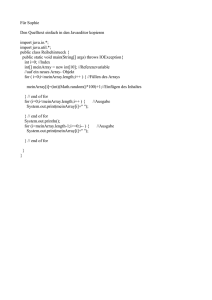
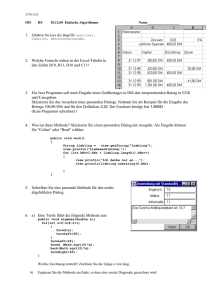
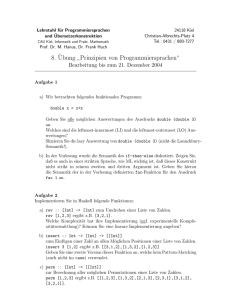

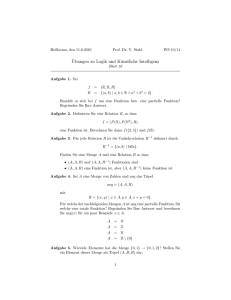
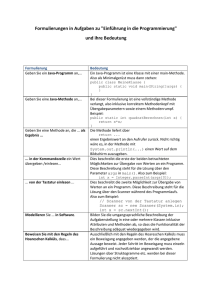
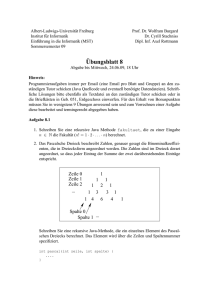
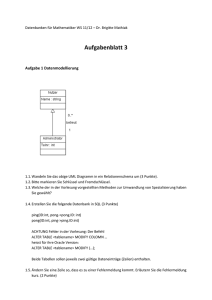
![Class ARTIKEL - OnlineML - michael.scheungraber[at]](http://s1.studylibde.com/store/data/008175981_1-4a6200e82f3b8640c2e204d91d3939dd-300x300.png)

